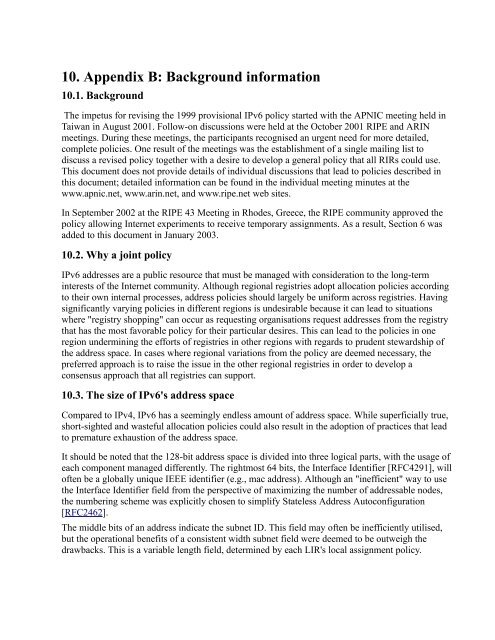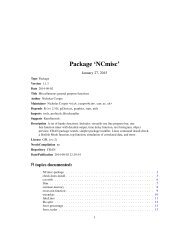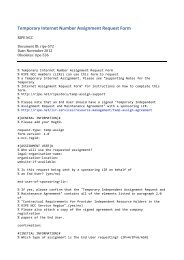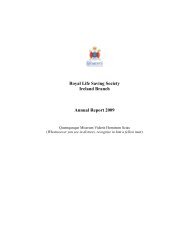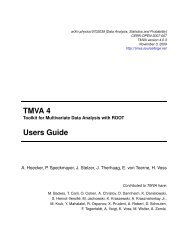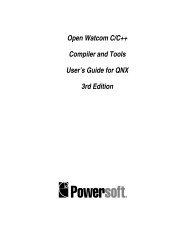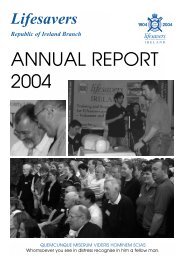IPv6 Address Allocation and Assignment Policy - RIPE NCC
IPv6 Address Allocation and Assignment Policy - RIPE NCC
IPv6 Address Allocation and Assignment Policy - RIPE NCC
Create successful ePaper yourself
Turn your PDF publications into a flip-book with our unique Google optimized e-Paper software.
10. Appendix B: Background information10.1. BackgroundThe impetus for revising the 1999 provisional <strong>IPv6</strong> policy started with the APNIC meeting held inTaiwan in August 2001. Follow-on discussions were held at the October 2001 <strong>RIPE</strong> <strong>and</strong> ARINmeetings. During these meetings, the participants recognised an urgent need for more detailed,complete policies. One result of the meetings was the establishment of a single mailing list todiscuss a revised policy together with a desire to develop a general policy that all RIRs could use.This document does not provide details of individual discussions that lead to policies described inthis document; detailed information can be found in the individual meeting minutes at thewww.apnic.net, www.arin.net, <strong>and</strong> www.ripe.net web sites.In September 2002 at the <strong>RIPE</strong> 43 Meeting in Rhodes, Greece, the <strong>RIPE</strong> community approved thepolicy allowing Internet experiments to receive temporary assignments. As a result, Section 6 wasadded to this document in January 2003.10.2. Why a joint policy<strong>IPv6</strong> addresses are a public resource that must be managed with consideration to the long-terminterests of the Internet community. Although regional registries adopt allocation policies accordingto their own internal processes, address policies should largely be uniform across registries. Havingsignificantly varying policies in different regions is undesirable because it can lead to situationswhere "registry shopping" can occur as requesting organisations request addresses from the registrythat has the most favorable policy for their particular desires. This can lead to the policies in oneregion undermining the efforts of registries in other regions with regards to prudent stewardship ofthe address space. In cases where regional variations from the policy are deemed necessary, thepreferred approach is to raise the issue in the other regional registries in order to develop aconsensus approach that all registries can support.10.3. The size of <strong>IPv6</strong>'s address spaceCompared to IPv4, <strong>IPv6</strong> has a seemingly endless amount of address space. While superficially true,short-sighted <strong>and</strong> wasteful allocation policies could also result in the adoption of practices that leadto premature exhaustion of the address space.It should be noted that the 128-bit address space is divided into three logical parts, with the usage ofeach component managed differently. The rightmost 64 bits, the Interface Identifier [RFC4291], willoften be a globally unique IEEE identifier (e.g., mac address). Although an "inefficient" way to usethe Interface Identifier field from the perspective of maximizing the number of addressable nodes,the numbering scheme was explicitly chosen to simplify Stateless <strong>Address</strong> Autoconfiguration[RFC2462].The middle bits of an address indicate the subnet ID. This field may often be inefficiently utilised,but the operational benefits of a consistent width subnet field were deemed to be outweigh thedrawbacks. This is a variable length field, determined by each LIR's local assignment policy.


